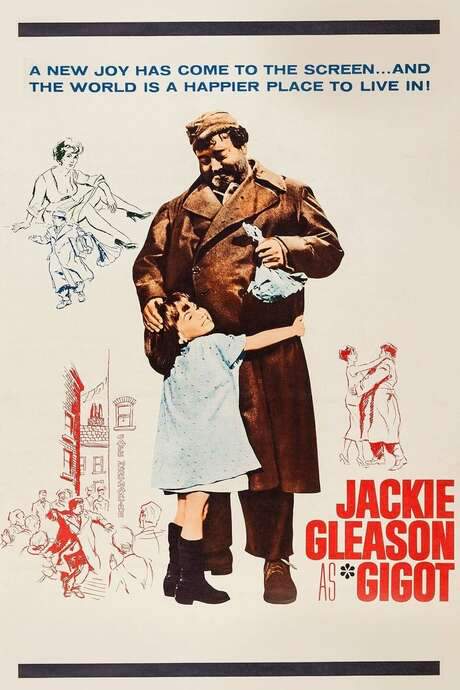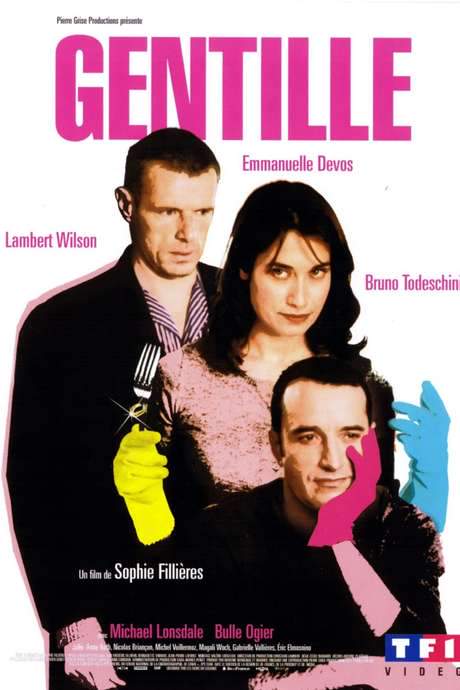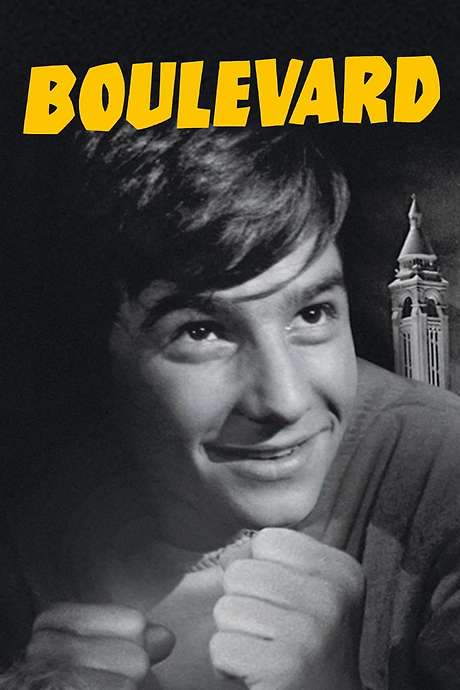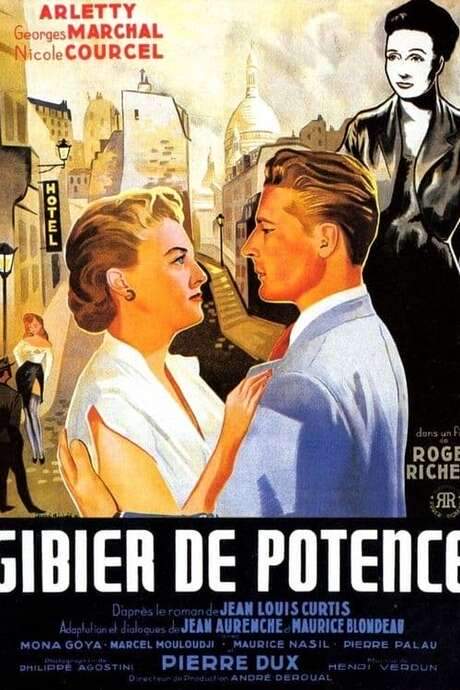
Gigot
Year: 1962
Runtime: 104 mins
Language: English
Director: Gene Kelly
A new joy arrives on screen, brightening the world. This poignant comedy follows a mute janitor who befriends Nicole, the young daughter of a prostitute. Jackie Gleason displays his considerable talent without speaking, playing the bumbling, kind‑hearted Gigot. Gleason also wrote the story and its music.
Warning: spoilers below!
Haven’t seen Gigot yet? This summary contains major spoilers. Bookmark the page, watch the movie, and come back for the full breakdown. If you're ready, scroll on and relive the story!
Gigot (1962) – Full Plot Summary & Ending Explained
Read the complete plot breakdown of Gigot (1962), including all key story events, major twists, and the ending explained in detail. Discover what really happened—and what it all means.
Gigot Jackie Gleason is a mute Frenchman who lives a spare, struggle-filled life in a damp basement tucked away in the Ménilmontant district of Paris during the 1920s. His days are spent as a janitor for the building owned by a stern landlady, and he moves through a world that regularly condescends to him and toys with him. Yet beneath the rough surface lies a quiet, enduring kindness that shines through in the way he treats the neighborhood children and the animals he feeds. One unusual habit marks his experience of life: he is irresistibly moved by funeral processions, and he finds himself attending them with a crush of emotions, crying alongside strangers even if he didn’t know the person who has died.
A turn comes when, after an incident at a pub, he stumbles upon Colette [Katherine Kath] and her six-year-old daughter Nicole, sheltering them in his dingy basement. Colette is wary at first, but exhaustion and cold compel her to accept his help. From that moment, Gigot’s gentleness becomes a defining thread in the story; he dotes on Nicole and discovers that she knows little about the world beyond their immediate need for warmth and safety. When she points to a crucifix and asks about God, Gigot’s struggle to explain the mystery of faith becomes a poignant image of communication without words. He tries to convey the idea of Christ as the savior, but Nicole cannot grasp the explanation; in a moment of frustration, Gigot lashes out with self-paced actions, only to have Nicole calm him with a simple imitation of his own gestures.
To keep Nicole entertained, Gigot digs into his old gramophone and dresses up as a waiter to feed his pet mouse, turning their basement into a stage for small joys. He becomes steadfastly protective, even running beside Nicole on a merry-go-round to ensure she doesn’t fall. He also intervenes to defend Colette’s dignity when she is involved with a man who has a history with prostitutes, stepping in to shield her from trouble and danger. That intervention leaves Gigot bruised; the man and his cohorts retaliate and beat him, a reminder of how fragile kindness can be in a harsh world.
Colette, frustrated by her precarious situation and her longing for a stable life, tells Gigot she needs a “man of means” to give Nicole a better future. Given only a short window to prove his worth, Gigot then finds himself pulled into a risky act: a bakery’s unattended till presents a tempting, ill-gotten opportunity. The bakery’s couple, who have long exploited him, are away, and Gigot takes what they have left behind. With those stolen coins, he buys clothes for Colette and Nicole, dons a new look with a straw boater and a shave, and treats them to a lavish meal at a restaurant. The moment is a rare flash of happiness, a brief glimpse of a possible normal life.
Yet happiness is fragile. Colette’s ex-boyfriend returns, eager to reclaim her, and Colette finds herself torn again. She envisions walking away with Nicole, but her pimp persuades her to wait, delaying any real escape to a safer life. The next morning, two bumbling bureaucrats arrive to move Gigot to a home for the feeble-minded, and the bakery theft is discovered, pulling Gigot further into suspicion. When Colette returns, she finds Gigot and Nicole missing, and the pair become fugitives in their own city.
They retreat to an abandoned basement chamber beneath the streets of Paris, where Gigot’s dances for Nicole become a lifeline of joy amid danger. But the building’s timbers give way during their playful moment, and they narrowly escape a collapse that leaves Nicole unconscious. Gigot rushes her to the church, where a priest calls a doctor, yet the little girl’s resolve to hear the music—her need for the gramophone—drives Gigot to risk everything to retrieve it.
As they move through the crowded streets, the mob closes in, and the gramophone slides from Gigot’s grasp onto a coal loader’s conveyor. Determined to save the source of joy for Nicole, Gigot climbs into the loader despite the danger and is dumped into the river with the gramophone in his arms. The crowd believes he’s dead, and the town, overwhelmed by remorse for their earlier cruelty, stages a funeral for him—burying only his hat as a token of mourning. Gigot survives, though, and hides, watching his own funeral procession from the sidelines. When the crowd finally spots him, recognition sparks a fresh chase that only deepens the cycle of pursuit and pity that has defined his life.
In this tale of quiet resilience and communal conscience, the human need for compassion collides with fear, judgment, and the memory of kindness withheld. The film invites us to consider how a single gentle soul can briefly illuminate a city’s shadows, even as misunderstanding and fear threaten to swallow him again. The story remains intimate in its focus on Gigot’s silent bravery, Colette’s longing for a better future, and Nicole’s innocent faith in the world’s small, hopeful moments.
Last Updated: October 07, 2025 at 08:26
Unlock the Full Story of Gigot
Don't stop at just watching — explore Gigot in full detail. From the complete plot summary and scene-by-scene timeline to character breakdowns, thematic analysis, and a deep dive into the ending — every page helps you truly understand what Gigot is all about. Plus, discover what's next after the movie.
Gigot Timeline
Track the full timeline of Gigot with every major event arranged chronologically. Perfect for decoding non-linear storytelling, flashbacks, or parallel narratives with a clear scene-by-scene breakdown.

Similar Movies to Gigot
Discover movies like Gigot that share similar genres, themes, and storytelling elements. Whether you’re drawn to the atmosphere, character arcs, or plot structure, these curated recommendations will help you explore more films you’ll love.
Explore More About Movie Gigot
Gigot (1962) Scene-by-Scene Movie Timeline
Gigot (1962) Movie Characters, Themes & Settings
Gigot (1962) Spoiler-Free Summary & Key Flow
Movies Like Gigot – Similar Titles You’ll Enjoy
France (2021) Film Overview & Timeline
My Afternoons with Margueritte (2011) Plot Summary & Ending Explained
Amélie (2001) Spoiler-Packed Plot Recap
Paris (2009) Plot Summary & Ending Explained
Gigi (1958) Plot Summary & Ending Explained
Gigli (2003) Film Overview & Timeline
French Girl (2024) Detailed Story Recap
Gentille (2005) Ending Explained & Film Insights
Boulevard (1960) Movie Recap & Themes
Gigolo (1951) Detailed Story Recap
Gribouille (1937) Film Overview & Timeline
Gigi (1949) Spoiler-Packed Plot Recap
A French Gigolo (2008) Full Movie Breakdown
Douce (1943) Complete Plot Breakdown
Gossette (1923) Spoiler-Packed Plot Recap

















